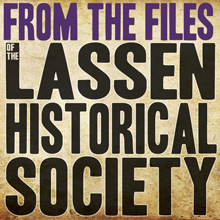
by Susan Couso
The Hewise people, known to many as the Pit River Indians, lived in a lush and varied area to the north of what is now Lassen County. This area had been their home since time began, but as the emigrants surged from the eastern United States, in the 1800’s, the Pit River land proved to be very enticing and valuable.
Emigrants claimed the land under the laws of the U. S. Government, completely ignoring the ancestral rights of the native people who lived there.
In 1859, the U. S. Army made a sweep through a wide swath of Northern California in an attempt to remove the Hewise and any others who got in their way. These people were taken forcibly from their homes and ordered to walk toward what would become a strange new destiny.
This is the story of one small group of people who were caught up in the shameful decision to relocate the Pit River people. The story is told by Leona Peconum, whose mother, Roxie Peconum, was born about 1854. It gives us a look into the trials of a people whose life was changed forever by a foreign power.
Roxie Peconum was just a little girl when she began her long journey. She remembered the time when U. S. Government soldiers were rounding up the Pit Rivers to move them to the Round Valley Reservation, in Mendocino County. There was a Pit River man helping the soldiers gather all the members of the Pit River tribe in the area.
However, in the process of bringing the Pit Rivers together, Roxie’s family, along with five to seven other Maidu families from Greenville and Big Meadows (Chester), were gathered by mistake.
No amount of pleading would sway the soldiers from including them in the round-up. They were Maidu, but to the soldiers, they were simply Indians.
They walked for months, then they were packed into a boat to, “cross the big water.”
The entire time, the small group of Maidu stayed by themselves, not mixing with the members of the Pit River tribe. The time spent on the boat was extremely stressful, but they finally came ashore. After leaving the boat, all of the Indians were given a place to stay. The time span was difficult to recall, but it was thought that they remained in the San Francisco area for about two years.
Eventually, a man in uniform, thought to be a soldier, approached the Maidu group. He explained that they had just found out that Roxie’s group wasn’t Pit River, so they could go home. Unfortunately, they would have to walk the entire way.
The soldier told them that they would be given two pack horses and some supplies for their journey. They were given an American flag and a paper rolled in a piece of buckskin. They were told to always keep the flag flying so that the ‘white people’ would know that they were peaceful Indians. Whenever they met these ‘white people’, they were to show them the rolled paper, and the people would help them.
Their journey home began, as they headed toward Kohm Yah-mah-nee (Lassen Peak).
They walked for many days before reaching an impassable river (thought to be the Sacramento River). The men searched the riverbank for a place to cross, and finally came across a small ferry. It was described as a raft with a pulley system with a man on each side to pull the raft across.
The men were set to board, but the Maidu women were afraid of being dumped into the water. The impasse was finally breached when it was explained to the women that this was their only way to ever get back home.
It must have taken a large amount of bravery to suppress their fears, but the women climbed aboard the contraption. Once across, they camped. A man passed by, and they showed the rolled paper to him. The mysterious paper seemed to work, for he pointed the way for them to go.
They journeyed on towards home. One day they came to a ranch with many horses. They had five or six young boys in their group, and the ranch foreman asked the Maidu boys if they knew how to ride horses.
None of the boys were horsemen, so the rancher offered to teach them. The rest of the Maidu were allowed to camp nearby. It took a month or so, but the boys did learn to ride. They also learned that the horses had been wild, and they had ‘broken’ them for the soldiers to use. They were proud of their accomplishment.
Then, it was time to head towards home, and the Maidu began to pack. The rancher gave them a new supply of food, a frying pan, a pot, and some strange beans.
He told them to brown the beans in the frying pan, then grind them. Then they were to boil a little of the ground beans in water and drink the liquid. He told them that this drink was called ‘coffee’. They learned to love this new ‘white man’s drink’.
The mountains began to pull them home again. As they met people along the way, they would show their rolled-up paper and get directions. Again, they arrived at a ranch where they were needed. The hay crop was ready, but there was not enough help. The boys came to the rescue and learned how to cut and stack the hay crop. The rancher was thankful and gave the small group a cabin to stay in while the boys worked. The Maidu were grateful but slept outside in the fresh air.
It took a while to get the work done, but the boys were happy to get work. In appreciation they cut, split and stacked the rancher’s wood before leaving again for home.
When they reached Oroville, they stayed for four or five months. The rest of their journey was going to be a bit difficult as there were unfriendly people between Oroville and home.
One day, Roxie’s mother met a woman who she had known as a young girl in Greenville. They chatted and discussed the trip home. The woman told her to follow a big river (probably the Feather River). The conditions weren’t the easiest, but it would take them to Quincy or Greenville.
By the time that they set out on their way, Autumn was in the air. They walked through the mountains and one day arrived at a place that Roxie’s father remembered. When he used to live in Greenville, he had come there to hunt. They were getting close. The journey continued until they reached Prattville, and the group separated.
Some families decided to go to Greenville, taking the American flag with them. Some went on to Mountain Meadows, and Roxie’s family turned toward Susanville.
The story of the Peconum family, and especially Roxie’s story has been told many times, as the Peconum family was a large part of Lassen County history. The stories of the native people of North America are filled with unfairness and strife, but they are also filled with beauty. Our past is a window into our future.







